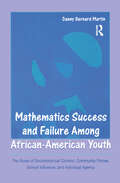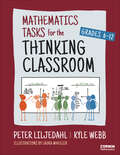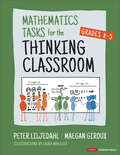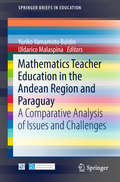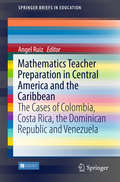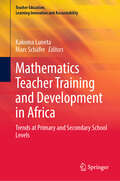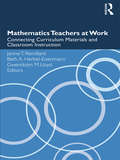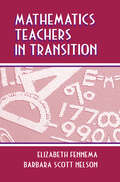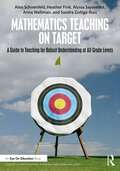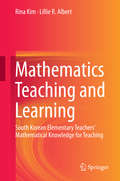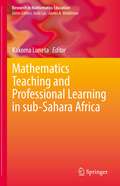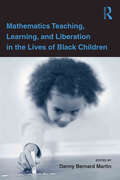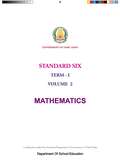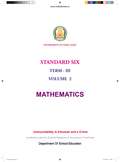- Table View
- List View
Mathematics Success and Failure Among African-American Youth: The Roles of Sociohistorical Context, Community Forces, School Influence, and Individual Agency (Studies in Mathematical Thinking and Learning Series)
by Danny Bernard MartinNo matter how mathematics achievement and persistence are measured, African Americans seem to lag behind their peers. This state of affairs is typically explained in terms of student ability, family background, differential treatment by teachers, and biased curricula. But what can explain disproportionately poor performance and persistence of African-American students who clearly possess the ability to do well, who come from varied family and socioeconomic backgrounds, who are taught by caring and concerned teachers, and who learn mathematics in the context of a reform-oriented mathematics curriculum? And, why do some African-American students succeed in mathematics when underachievement is the norm among their fellow students? Danny Martin addresses these questions in Mathematics Success and Failure Among African-American Youth, the results of a year-long ethnographic and observational study of African-American students and their parents and teachers. Mathematics Success and Failure Among African-American Youth goes beyond the conventional explanations of ability, socioeconomic status, differential treatment, and biased curricula to consider the effects of history, community, and peers--and the individual agency that allows some students to succeed despite these influences. Martin's analysis suggests that prior studies of mathematics achievement and persistence among African Americans have failed to link sociohistorical, community, school, and intrapersonal forces in sufficiently meaningful ways, and that they suffer from theoretical and methodological limitations that hinder the ability of mathematics educators to reverse the negative achievement and persistence trends that continue to afflict African-American students. The analyses and findings offered in Martin's book lead to exciting implications for future research and intervention efforts concerning African-American students--and other students for whom history and context play an important role. This book will be useful and informative to many groups: mathematics education researchers, education researchers interested in the social context of learning and teaching, policymakers, preservice and in-service teachers, students, parents, and community advocates. It will also be of interest to readers concerned with multicultural education, cross-cultural studies of mathematics learning, sociology of education, Black Studies, and issues of underrepresentation in science and mathematics.
Mathematics Tasks for the Thinking Classroom, Grades 6-12 (Corwin Mathematics Series)
by Peter Liljedahl Kyle WebbPractical and proven math tasks to maximize student thinking and learning Building upon the blockbuster success of Building Thinking Classrooms in Mathematics, Peter Liljedahl has joined forces with co-author Kyle Webb to bring the Building Thinking Classrooms (BTC) framework to life in this new book, Mathematics Tasks for the Thinking Classroom, Grades 6-12. But this book is so much more than simply a collection of good thinking tasks. It delves deeper into the implementation of the 14 practices from the BTC framework by updating the practices with the newest research, and focusing on the practice through the lens of rich math tasks that address specific mathematical learning outcomes or standards. Across the 20 non-curricular tasks and 30 curricular tasks used as models, this book: Helps you choose tasks to fit your particular math standards, goals, and the competencies you want your students to build Walks you through all the steps and scripts to launch, facilitate, and consolidate each task Shares examples of possible student solutions along with hints you might offer to help their thinking along Offers tasks for consolidation, example notes to my future forgetful self, and mild, medium, and spicy check-your-understanding questions (CYUs) for every thin sliced sequences of curricular tasks Imparts reflections from the authors on each task The book closes with specific guidance on how to find more tasks or craft your own non-curricular and curricular tasks, along with answers to educators’ frequently asked questions. It includes access to a companion website that includes downloadables and a task template for creating your own tasks. Whether you are new to BTC or a seasoned user, Mathematics Tasks for the Thinking Classroom, Grades 6-12 will help teachers, coaches, and specialists transform traditional math classrooms into dynamic and thought-provoking learning spaces. Mathematics Tasks for the Thinking Classroom, Grades K-5 is also available to create district-wide thinking classrooms!
Mathematics Tasks for the Thinking Classroom, Grades 6-12 (Corwin Mathematics Series)
by Peter Liljedahl Kyle WebbPractical and proven math tasks to maximize student thinking and learning Building upon the blockbuster success of Building Thinking Classrooms in Mathematics, Peter Liljedahl has joined forces with co-author Kyle Webb to bring the Building Thinking Classrooms (BTC) framework to life in this new book, Mathematics Tasks for the Thinking Classroom, Grades 6-12. But this book is so much more than simply a collection of good thinking tasks. It delves deeper into the implementation of the 14 practices from the BTC framework by updating the practices with the newest research, and focusing on the practice through the lens of rich math tasks that address specific mathematical learning outcomes or standards. Across the 20 non-curricular tasks and 30 curricular tasks used as models, this book: Helps you choose tasks to fit your particular math standards, goals, and the competencies you want your students to build Walks you through all the steps and scripts to launch, facilitate, and consolidate each task Shares examples of possible student solutions along with hints you might offer to help their thinking along Offers tasks for consolidation, example notes to my future forgetful self, and mild, medium, and spicy check-your-understanding questions (CYUs) for every thin sliced sequences of curricular tasks Imparts reflections from the authors on each task The book closes with specific guidance on how to find more tasks or craft your own non-curricular and curricular tasks, along with answers to educators’ frequently asked questions. It includes access to a companion website that includes downloadables and a task template for creating your own tasks. Whether you are new to BTC or a seasoned user, Mathematics Tasks for the Thinking Classroom, Grades 6-12 will help teachers, coaches, and specialists transform traditional math classrooms into dynamic and thought-provoking learning spaces. Mathematics Tasks for the Thinking Classroom, Grades K-5 is also available to create district-wide thinking classrooms!
Mathematics Tasks for the Thinking Classroom, Grades K-5 (Corwin Mathematics Series)
by Peter Liljedahl Maegan GirouxPractical and proven math tasks to maximize student thinking and learning Building upon the blockbuster success of Building Thinking Classrooms in Mathematics, Peter Liljedahl has joined forces with co-author Maegan Giroux to bring the Building Thinking Classrooms (BTC) framework to life in this new book, Mathematics Tasks for the Thinking Classroom, Grades K-5. But this book is so much more than simply a collection of good thinking tasks. It delves deeper into the implementation of the 14 practices from the BTC framework by updating the practices with the newest research, and focusing on the practice through the lens of rich math tasks that address specific mathematical learning outcomes or standards. Across the 20 non-curricular tasks and 30 curricular tasks used as models, this book: Helps you choose tasks to fit your particular math standards, goals, and the competencies you want your students to build Walks you through all the steps and scripts to launch, facilitate, and consolidate each task Shares examples of possible student solutions along with hints you might offer to help their thinking along Offers tasks for consolidation, example notes to my future forgetful self, and mild, medium, and spicy check-your-understanding questions (CYUs) for every thin sliced sequences of curricular tasks Imparts reflections from the authors on each task The book closes with specific guidance on how to find more tasks or craft your own non-curricular and curricular tasks, along with answers to educators’ frequently asked questions. It includes access to a companion website that includes downloadables and a task template for creating your own tasks. Whether you are new to BTC or a seasoned user, Mathematics Tasks for the Thinking Classroom, Grades K-5 will help teachers, coaches, and specialists transform traditional math classrooms into dynamic and thought-provoking learning spaces.
Mathematics Tasks for the Thinking Classroom, Grades K-5 (Corwin Mathematics Series)
by Peter Liljedahl Maegan GirouxPractical and proven math tasks to maximize student thinking and learning Building upon the blockbuster success of Building Thinking Classrooms in Mathematics, Peter Liljedahl has joined forces with co-author Maegan Giroux to bring the Building Thinking Classrooms (BTC) framework to life in this new book, Mathematics Tasks for the Thinking Classroom, Grades K-5. But this book is so much more than simply a collection of good thinking tasks. It delves deeper into the implementation of the 14 practices from the BTC framework by updating the practices with the newest research, and focusing on the practice through the lens of rich math tasks that address specific mathematical learning outcomes or standards. Across the 20 non-curricular tasks and 30 curricular tasks used as models, this book: Helps you choose tasks to fit your particular math standards, goals, and the competencies you want your students to build Walks you through all the steps and scripts to launch, facilitate, and consolidate each task Shares examples of possible student solutions along with hints you might offer to help their thinking along Offers tasks for consolidation, example notes to my future forgetful self, and mild, medium, and spicy check-your-understanding questions (CYUs) for every thin sliced sequences of curricular tasks Imparts reflections from the authors on each task The book closes with specific guidance on how to find more tasks or craft your own non-curricular and curricular tasks, along with answers to educators’ frequently asked questions. It includes access to a companion website that includes downloadables and a task template for creating your own tasks. Whether you are new to BTC or a seasoned user, Mathematics Tasks for the Thinking Classroom, Grades K-5 will help teachers, coaches, and specialists transform traditional math classrooms into dynamic and thought-provoking learning spaces.
Mathematics Teacher Education in the Andean Region and Paraguay: A Comparative Analysis of Issues and Challenges (SpringerBriefs in Education)
by Uldarico Malaspina Yuriko Yamamoto Baldin Jill AdlerThis book is an excellent synthesis of the initial and continuing preparation for Mathematics Teaching in Bolivia, Ecuador, Paraguay and Peru, from which comparative analyses can be made that show similarities and differences, and highlight various perspectives. In February 2016, the 5th Capacity and Networking Project (CANP) workshop of the International Commission on Mathematical Instruction (ICMI) was held in Lima, Peru. The coordination of this two-week workshop was undertaken by an international scientific committee (IPC), with equal participation by mathematicians and mathematics educators from the region and from the international ICMI and IMU community. The goal of CANP5 was to improve the quality of mathematics education in the region, which led to the main theme of the scientific program “Initial and Continued Teacher Education”. Country Reports on the main theme of teacher education systems for each country in this region were presented and discussed to detect common issues that might be improved through a collaborative network. One of the most important results of this event was the creation of a Mathematics Education Network, namely the Comunidad de Educación Matemática de America del Sur – CEMAS. This book brings to the international Educational Community an important collection of experiences and ideas in the Mathematics Education of four Latin-American countries in the developing Andean region and Paraguay. The dissemination of these results can promote the search for international collaborative actions in a wider scale.
Mathematics Teacher Preparation in Central America and the Caribbean: The Cases of Colombia, Costa Rica, the Dominican Republic and Venezuela (SpringerBriefs in Education)
by Angel RuizThis Open Access book is an excellent synthesis of the initial and continuing preparation for Mathematics Teaching in Colombia, Costa Rica, Dominican Republic and Venezuela, from which comparative analyses can be made that show similarities and differences, and highlight various perspectives.In August 2012, a workshop of the Capacity and Networking Project (CANP) of the International Commission on Mathematical Instruction (ICMI) was held in Costa Rica. This CANP brought together for two weeks a group of 66 Mathematics educators, mathematicians, university administrators, and elementary and secondary teachers from Colombia, Venezuela, the Dominican Republic, Panamá and Costa Rica. The goal was to promote progress in Mathematics Education in the region; as such it was a unique experience in the region. One of the most important results of this event was the creation of the Mathematics Education Network of Central America and the Caribbean (REDUMATE). It was organized by persons associated with the Mathematics Education Reform Project in Costa Rica (responsible for the most outstanding and innovative curriculum reform in Latin America) and the Inter-American Committee on Mathematics Education (IACME), which is an official regional multinational organization affiliate of ICMI.This book brings to the international Educational Community an important collection of experiences and ideas in the Mathematics Education of four countries of a region within the heart of the American continent, a region that has been many times forgotten. The dissemination of these results can promote the search for international collaborative actions in a wider scale.
Mathematics Teacher Training and Development in Africa: Trends at Primary and Secondary School Levels (Teacher Education, Learning Innovation and Accountability)
by Kakoma Luneta Marc SchäferThis edited volume addresses the need for reforms in mathematics teacher training, spurred by scientific advancements and societal changes, encompassing calls for changes in curricula, content, and instructional methods. The text highlights the complexities of teaching mathematics, specifically within Africa. It provides an exploration into how mathematics teacher training has evolved to address challenges such as ineffective teaching approaches, lack of resources, technological limitations, and outdated training programs. Through comprehensive systematic reviews for each country in the African region, documentation is provided on the past, present, and envisioned future of teacher training programs. This undertaking provides a detailed analysis of mathematics teacher training, offering valuable insights for teacher trainers, government ministries of education, and stakeholders across Africa. For anyone invested in enhancing mathematics education in the region, this book offers indispensable guidance and knowledge.
Mathematics Teachers at Work: Connecting Curriculum Materials and Classroom Instruction (Studies in Mathematical Thinking and Learning Series)
by Janine T. Remillard Beth A. Herbel-Eisenmann Gwendolyn M. LloydThis book compiles and synthesizes existing research on teachers’ use of mathematics curriculum materials and the impact of curriculum materials on teaching and teachers, with a particular emphasis on – but not restricted to – those materials developed in the 1990s in response to the NCTM’s Principles and Standards for School Mathematics. Despite the substantial amount of curriculum development activity over the last 15 years and growing scholarly interest in their use, the book represents the first compilation of research on teachers and mathematics curriculum materials and the first volume with this focus in any content area in several decades.
Mathematics Teachers in Transition (Studies in Mathematical Thinking and Learning Series)
by Elizabeth Fennema Barbara Scott NelsonThis book addresses the need of professional development leaders and policymakers for scholarly knowledge about influencing teachers to modify mathematical instruction to bring it more in alignment with the recommendations of the current reform movement initiated by the National Council of Teachers of Mathematics. The book presents: * theoretical perspectives for studying, analyzing, and understanding teacher change; * descriptions of contextual variables to be considered as one studies and attempts to understand teacher change; and * descriptions of professional development programs that resulted in teacher change. One chapter builds a rationale for looking to developmental psychology for guidance in constructing models of reconstructing new forms of mathematical instruction. Another highlights the relevance to mathematics teacher development of research-based knowledge about how children construct mathematical ideas. Other chapters explore the relationships between the various contexts of schooling and instructional change. Included also are chapters that describe and analyze major reform efforts designed to assist teachers in modifying their instructional practices (Cognitively Guided Instruction, Math-Cubed, Project Impact, Mathematics in Context, and the Case-Based Project). Finally, the current state of knowledge about encouraging teachers to modify their instruction is discussed, the implications of major research and implementation findings are suggested, and some of the major questions that need to be addressed are identified, such as what we have learned about teacher change.
Mathematics Teaching On Target: A Guide to Teaching for Robust Understanding at All Grade Levels (Studies in Mathematical Thinking and Learning Series)
by Anna Weltman Alan Schoenfeld Heather Fink Alyssa Sayavedra Sandra Zuñiga-RuizMathematics Teaching On Target is a guidebook for improving mathematics teaching, based on the Teaching for Robust Understanding (TRU) Framework and its five dimensions – The Mathematics, Cognitive Demand, Equitable Access, Agency, Ownership, and Identity, and Formative Assessment. You’ll be guided to refine your classroom activities across the five TRU dimensions, and your students will become more knowledgeable and resourceful thinkers and problem solvers. Each chapter in Mathematics Teaching On Target introduces a set of easy-to-use questions for the hands-on improvement of lesson activities, such as: · Think of an activity you use with your students. Is it as mathematically rich as it might be? · Does it stretch your students in the right ways, inviting “productive struggle”? · Can all students engage with it, in ways that allow them to grow as mathematical thinkers? · What evidence will student work provide, helping you revise the activity so that it works better both in the moment and next time? You’ll find examples at the elementary, middle, and secondary levels for each dimension that show how addressing these questions can enhance mathematics instruction. Ideal for your individual classroom, learning community, or district-level and wider professional development efforts, this book will enable you to help more students engage with mathematics in increasingly powerful ways. Beyond individual lessons, this book will also accelerate teacher development by helping you focus and reflect on what really counts in your instruction.
Mathematics Teaching and Learning
by Lillie R. Albert Rina KimThe purpose of this research is to identify the categories of South Korean elementary teachers' knowledge for teaching mathematics. Emerging from the data collected and the subsequent analysis are five categories of South Korean elementary teachers' knowledge for teaching mathematics: Mathematics Curriculum Knowledge, Mathematics Learner Knowledge, Fundamental Mathematics Conceptual Knowledge, Mathematics Pedagogical Content Knowledge, and Mathematics Pedagogical Procedural Knowledge. The first three categories of knowledge play a significant role in mathematics instruction as an integrated form within Mathematics Pedagogical Content Knowledge. This study also demonstrated that Mathematics Pedagogical Procedural Knowledge might play a pivotal role in constructing Mathematics Pedagogical Content Knowledge. These findings are connected to results from relevant studies in terms of the significant role of teachers' knowledge in mathematics instruction.
Mathematics Teaching and Professional Learning in sub-Sahara Africa (Research in Mathematics Education)
by Kakoma LunetaThe book represents a crop of wide-ranging research conducted by renown scholars in sub-Sahara Africa revolving around mathematics teaching and professional development programs for mathematics teachers. The research-based proposals and actual how-to-conduct professional development initiatives that enhance effective mathematics instruction are rooted in teacher input and informed by learners’ errors and misconceptions. The book provides a comprehensive snapshot on mathematics teaching, learning and effective professional development programmes for mathematics teachers in sub-Sahara Africa. It is the only research output that advances and disseminates issues of mathematics education and research in the region with input from South Africa, Kenya, Rwanda, Uganda, Malawi, Namibia, Lesotho, Ethiopia and Zimbabwe.
Mathematics Teaching, Learning, and Liberation in the Lives of Black Children (Studies in Mathematical Thinking and Learning Series)
by Danny Bernard MartinWith issues of equity at the forefront of mathematics education research and policy, Mathematics Teaching, Learning, and Liberation in the Lives of Black Children fills the need for authoritative, rigorous scholarship that sheds light on the ways that young black learners experience mathematics in schools and their communities. This timely collection significantly extends the knowledge base on mathematics teaching, learning, participation, and policy for black children and it provides new framings of relevant issues that researchers can use in future work. More importantly, this book helps move the field beyond analyses that continue to focus on and normalize failure by giving primacy to the stories that black learners tell about themselves and to the voices of mathematics educators whose work has demonstrated a commitment to the success of these children.
Mathematics Term 1 Volume 2 class 6 - S.C.E.R.T - Tamil Nadu Board
by Tamil GovernmentThis book introduces the student to the foundations over which the subject had developed in the past, the content it offers now and the changes that it had undergone. Mathematics is a unique symbolic language in which the world works and acts so. This textbook is an attempt to make the learning of Mathematics easy for the student’s community and which is explained in each unit.
Mathematics Term 2 Volume 2 class 6 - S.C.E.R.T - Tamil Nadu Board
by Tamil GovernmentThis book introduces the student to the foundations over which the subject had developed in the past, the content it offers now and the changes that it had undergone. Mathematics is a unique symbolic language in which the world works and acts so. This textbook is an attempt to make the learning of Mathematics easy for the student’s community and which is explained in each unit.
Mathematics Term 3 Volume 2 class 6 - S.C.E.R.T - Tamil Nadu Board
by Tamil GovernmentMathematics Term - III (Volume 2) 6th Standard book introduces the student to the foundations over which the subject had developed in the past, the content it offers now and the changes that it had undergone. Mathematics is a unique symbolic language in which the world works and acts so. This textbook is an attempt to make the learning of Mathematics easy for the student’s community and which is explained in each unit.
Mathematics Term-1 class 7 - Tamil Nadu Board: கணக்கு ஏழாம் வகுப்பு பருவம் 1
by State Council of Educational Research and Training Tamil Naduஏழாம் வகுப்பு கணிதம் முதல் பருவம் தமிழ்நாடு பாடத்திட்டம் 2023 புத்தகத்தில் எண்கள், இயற்கணிதம், வடிவியல், புள்ளியியல் மற்றும் தரவு கையாளுதல் ஆகிய அடிப்படை கணிதக் கருத்துக்கள் அடங்கியுள்ளன. இந்த பாடத்திட்டம் மாணவர்களின் தர்க்கரீதியான சிந்தனை மற்றும் கணித திறன்களை மேம்படுத்துவதற்கு வடிவமைக்கப்பட்டுள்ளது.
Mathematics Term-2 class 7 - Tamil Nadu Board: கணக்கு ஏழாம் வகுப்பு பருவம் 2
by State Council of Educational Research and Training Tamil Naduஏழாம் வகுப்பு கணிதம் இரண்டாம் பருவம் தமிழ்நாடு பாடத்திட்டம் 2023 புத்தகத்தில் விகிதம் மற்றும் விகித சமம், வட்டம், பரப்பளவு மற்றும் சுற்றளவு, நிகழ்தகவு மற்றும் தரவு கையாளுதல் ஆகிய முக்கியமான கணிதக் கருத்துக்கள் இடம்பெற்றுள்ளன. இந்த பாடத்திட்டம் மாணவர்களின் கணித அறிவை விரிவுபடுத்தி, தர்க்கரீதியான சிந்தனையை ஊக்குவிக்க வடிவமைக்கப்பட்டுள்ளது.

